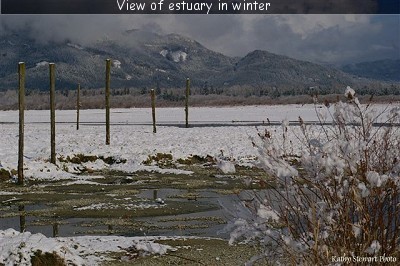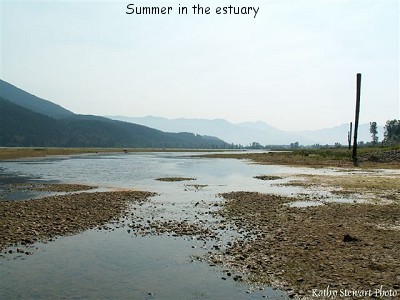Site Guide to the Chehalis Estuary
by Kathy Stewart
 The Chehalis Estuary is a unique area formed where the Chehalis River flows into the Harrison River. During late fall, winter and early spring, when water levels are normally low, a vast expanse of grasslands, gravel and sand bars are exposed, extending south, almost to the Harrison Bridge on highway #7 and west to Morris Valley Road. As snow packs melt, water levels rise until the entire area is covered in water to form a 'lake'. This diverse and varying habitat lends itself to a diverse and varying bird population. The value of the Chehalis estuary has been recognized by Duck's Unlimited who own part of the grasslands area adjacent to Morris Valley Road and by Nature Trust B.C. who own the mixed forest and grasslands area along the northern edge of the estuary. Since the entire area is an important Salmon spawning ground, all of it, including the exposed gravel bars, falls under the protection of the department of Fisheries. The Chehalis Estuary is a unique area formed where the Chehalis River flows into the Harrison River. During late fall, winter and early spring, when water levels are normally low, a vast expanse of grasslands, gravel and sand bars are exposed, extending south, almost to the Harrison Bridge on highway #7 and west to Morris Valley Road. As snow packs melt, water levels rise until the entire area is covered in water to form a 'lake'. This diverse and varying habitat lends itself to a diverse and varying bird population. The value of the Chehalis estuary has been recognized by Duck's Unlimited who own part of the grasslands area adjacent to Morris Valley Road and by Nature Trust B.C. who own the mixed forest and grasslands area along the northern edge of the estuary. Since the entire area is an important Salmon spawning ground, all of it, including the exposed gravel bars, falls under the protection of the department of Fisheries.
It is the Salmon's arrival in October that draws the Bald Eagles in the hundreds. Glaucous-winged Gulls number in the thousands, with a few Herring and Mew Gull as well. All feasting on the spawned out salmon. During this time American Pipit are sometimes seen on the barren gravel bars and Great Blue Heron stand sentinel along any of the numerous waterways that wend their way through the grassland. Mallard and Common Merganser are seen in the area year round while Hooded Merganser inhabit the shallower backwater areas. Belted Kingfisher are regularly seen, often perched on the wires along Morris Valley Road. Gulls number in the thousands, with a few Herring and Mew Gull as well. All feasting on the spawned out salmon. During this time American Pipit are sometimes seen on the barren gravel bars and Great Blue Heron stand sentinel along any of the numerous waterways that wend their way through the grassland. Mallard and Common Merganser are seen in the area year round while Hooded Merganser inhabit the shallower backwater areas. Belted Kingfisher are regularly seen, often perched on the wires along Morris Valley Road.
Trumpeter Swan with the occasional Tundra Swan arrive in mid November and will spend most of  the winter in the area, depending on water depth. By late January the eagles have moved on with only a few residents left in the area. Bufflehead and Green-winged Teal join the Mallards for the winter. Most winters, a large flock of male Red-winged Blackbirds spend the winter in the area. Winter Wren, Song Sparrow, Towhee and Gold Crowned Kinglets are frequently spotted in the underbrush along the edges of the wetlands. Killdeer and the occasional Dunlin can sometimes be seen out on the flats. the winter in the area, depending on water depth. By late January the eagles have moved on with only a few residents left in the area. Bufflehead and Green-winged Teal join the Mallards for the winter. Most winters, a large flock of male Red-winged Blackbirds spend the winter in the area. Winter Wren, Song Sparrow, Towhee and Gold Crowned Kinglets are frequently spotted in the underbrush along the edges of the wetlands. Killdeer and the occasional Dunlin can sometimes be seen out on the flats. Spring migration often brings Lesser Yellowlegs and other shorebirds to the area. Sandhill Crane have been known to stop by on the flats. Tree Swallows are the first of the swallows to return but will soon be joined by Barn Swallow and Northern Rough-winged Swallows all of which nest in the area. Purple Martin boxes have been erected in the area and were visited last year by at least one Purple Martin with hopes that more will return this year. Mountain Bluebirds, Townsend's Solitaire and Western Meadowlark can all be depended upon to stop over. Rufous Hummingbirds spend the summer in the area and Calliope are spotted regularly as they migrate to the interior.
By late spring the riparian habitat is alive with warblers. Common Yellowthroat and Yellow Warblers nest in the area. Yellow-rumped Warblers are common during spring and fall migration. Osprey and Turkey Vultures are now seen regularly flying over head. Depending on water levels, the call of the Common Loon may be heard. Pied-billed Grebe most certainly will be. Wood Duck are hidden up quieter channels while Marsh Wren , American Bittern and Wilson's Snipe inhabit the grassy areas. Cedar Waxwing and Black-headed Grosbeak are regulars in the mixed forest at the edges of the estuary as is the more illusive Gray Catbird. Spotted Sandpiper raise their young along the edges of the high water level and Canada Goose families are seen regularly. nest in the area. Yellow-rumped Warblers are common during spring and fall migration. Osprey and Turkey Vultures are now seen regularly flying over head. Depending on water levels, the call of the Common Loon may be heard. Pied-billed Grebe most certainly will be. Wood Duck are hidden up quieter channels while Marsh Wren , American Bittern and Wilson's Snipe inhabit the grassy areas. Cedar Waxwing and Black-headed Grosbeak are regulars in the mixed forest at the edges of the estuary as is the more illusive Gray Catbird. Spotted Sandpiper raise their young along the edges of the high water level and Canada Goose families are seen regularly.
 The dropping of water levels in late summer coincides with the shorebirds fall migration. Solitary Sandpiper, Least Sandpiper, Baird's Sandpiper and Pectoral Sandpiper have all been spotted during this time. Northern Shoveler, Northern Pintail, and American Wigeon are just some of the ducks using the area as a rest stop. The dropping of water levels in late summer coincides with the shorebirds fall migration. Solitary Sandpiper, Least Sandpiper, Baird's Sandpiper and Pectoral Sandpiper have all been spotted during this time. Northern Shoveler, Northern Pintail, and American Wigeon are just some of the ducks using the area as a rest stop.
Life in the area is not just limited to birds. Coyote are seen in the area year round. Deer can occasionally be spotted at the edges of the estuary. Black Bear are common visitors during salmon spawning time. Cougar and Bobcat are illusive visitors while Beaver, River Otter and Raccoon are seen on a regular basis. Summer evening skies are filled with Bats as they feast on the abundant mosquito population.
Fortunately for the creatures that are so dependent on it access to the Chehalis Estuary is limited. The area is best explored by canoe or kayak, during times of high water. Several pullouts on Morris Valley Road allow for viewing the grasslands. Eagle Point Community Park contains a viewing platform for viewing the gravel flats. This small park runs along the western edge of the estuary. Due to the extremely sensitive habitat visitors are asked to remain on the graveled trail and to keep pets on a lead. Take highway #7, west from Agassiz or east from Mission, turn north on Morris Valley Road, a small unmarked parking lot is situated approximately 2.5 km from the turn off, a fenced path bisecting the housing developments of Eagle Point and River's Reach leads to the park itself.
Kathy Stewart

|